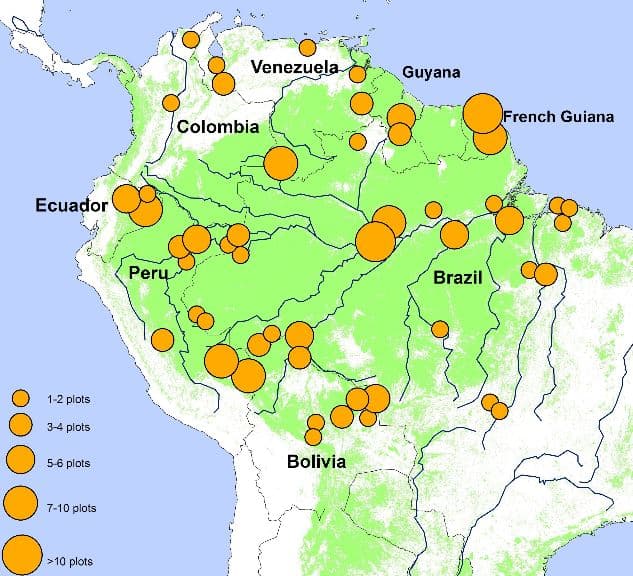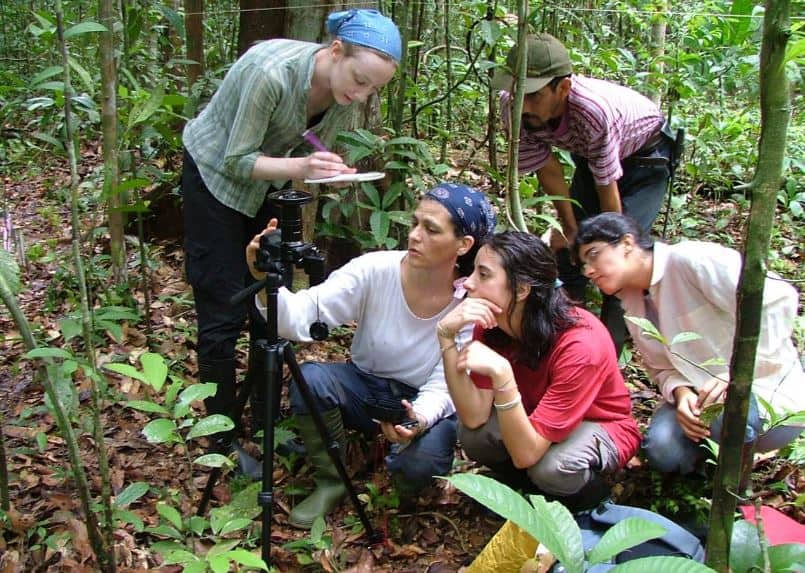The Amazon rainforest’s capacity to absorb carbon from the atmosphere has declined by about 50% compared to the 1990s, nearly 100 researchers led by the University of Leeds in England reported in the academic journal Nature.
In the 1990s, the Amazon’s atmospheric carbon capture reached a peak of two billion tonnes annually. Today, however, it cannot even manage to absorb the fossil fuel emissions emanating from Latin American.
The study, which gathered and analyzed data on the South American rainforest over the past 30 years, found a huge surge in the rate of trees dying.

The scientists monitored 321 plots across the rainforest. (Image Credit: Georgia Pickavance, RAINFOR / GLC2000)
Lead author Dr. Roel Brienen, who works at Leeds University’s School of Geography, said:
“Tree mortality rates have increased by more than a third since the mid-1980s, and this is affecting the Amazon’s capacity to store carbon.”
Higher CO2 makes trees die younger
An increase in atmospheric CO2 levels initially led to a growth spurt for the rainforest’s trees, the researchers said. CO2 is a key ingredient for photosynthesis.
However, the additional carbon appears to have had unexpected consequences – trees’ lifespans are reduced.
Co-author Professor Oliver Phillips, who also works at the School of Geography, said:
“With time, the growth stimulation feeds through the system, causing trees to live faster, and so die younger.”

RAINFOR team monitoring the Amazon canopy in Peru. (Image Credit: Kuo-Jung Chao)
Unusually high temperatures and recent droughts that have ravaged the Amazon might also be playing a role.
Even though tree mortality increases started well before an intense 2005 drought, since then further prolonged dry periods have killed millions of additional trees, the researchers reported.
Dr Brienen warned:
“Regardless of the causes behind the increase in tree mortality, this study shows that predictions of a continuing increase of carbon storage in tropical forests may be too optimistic.”
“Climate change models that include vegetation responses assume that as long as carbon dioxide levels keep increasing, then the Amazon will continue to accumulate carbon. Our study shows that this may not be the case and that tree mortality processes are critical in this system.”
The project involved nearly 100 researchers, many of them working for decades across eight nations in South America.

Measuring Amazon trees in Peru. (Image Credit: Roel Brienen)
The study was coordinated by RAINFOR, a unique research network dedicated to understanding Amazon ecosystems from the ground up.
To determine whether carbon storage has changed, and if so by how much, the scientists examined 321 forest plots across the Amazon’s six million square kilometers, identified and measured more than 200,000 trees, and recorded tree deaths and births since the 1980s.
Prof. Phillips said:
“All across the world even intact forests are changing. Forests are doing us a huge favour, but we can’t rely on them to solve the carbon problem. Instead, deeper cuts in emissions will be required to stabilise our climate.”
Citation: “Long-term decline of the Amazon carbon sink,” R. J. W. Brienen, O. L. Phillips, T. R. Feldpausch, E. Gloor, T. R. Baker, J. Lloyd, G. Lopez-Gonzalez, A. Monteagudo-Mendoza, Y. Malhi, S. L. Lewis, R. Vásquez Martinez, M. Alexiades, E. Álvarez Dávila, P. Alvarez-Loayza, A. Andrade, L. E. O. C. Aragão, A. Araujo-Murakami, E. J. M. M. Arets, L. Arroyo, G. A. Aymard C., O. S. Bánki, C. Baraloto, J. Barroso, D. Bonal, R. G. A. Boot + et al. Nature. Published March 19, 2015. DOI: doi:10.1038/nature14283.
